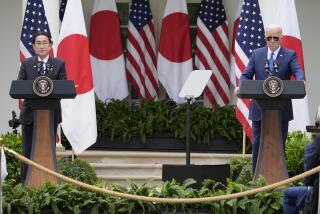Japan Eases Policy to Jump Start Economy
- Share via
TOKYO — In an attempt to rouse the comatose economy, Japan’s central bank Tuesday announced that it would further ease monetary policy by taking a series of interventionist steps it has long resisted.
Japan’s interest rates are already close to zero, so stimulating demand can’t be achieved by simply cutting rates, a course the Federal Reserve has aggressively pursued in recent months as the U.S. economy has headed south.
Rather, the Bank of Japan on Tuesday said it would force more cash into the system through a series of operations known as quantitative easing. Specifically, it agreed to boost the amount of money it holds available for member banks to $48 billion, an $8-billion boost, and to increase its monthly purchases of government bonds by about a third, to $4.9 billion.
The steps represent relatively small amounts but a big policy shift for the central bank, which has long argued against such an approach on the grounds that Japanese companies and regulators need to do more heavy lifting and restructuring themselves before monetary policy can have much impact.
Stocks soared 3.8% as the benchmark Nikkei average closed at 11,917.95, up 440.39. And the yen also weakened before staging a modest comeback.
“It was an exciting day,” said Masaki Kanno, chief economist with J.P. Morgan Securities. “The market was certainly surprised.”
Beneath the market exuberance, however, are some real questions about the policy, its impact on Japan as well as on Asia and the way the central bank is defining its role. The effort will be watched closely around the world in part because regulators of the world’s second-largest economy are going where none has gone before.
“Basically a lot of other central banks don’t want to end up in the mess Japan is in,” said Richard Jerram, an economist with ING Barings. “You’ve got an extremely weak economy, very little demand and deflation.”
Some analysts welcomed the turnaround as evidence that authorities were listening carefully to the market and taking Japan’s looming crisis seriously. “The impact of the easing will be limited,” said Chisato Haganuma, senior strategist with Nomura Securities. “But it’s psychologically important.”
Others said the move might prove to be almost as ineffective as doing nothing. By backing down, the central bank has signaled just how worried it is about the economy, critics said. Yet its tepid response--a few billion isn’t much for central banks--may squander its political capital, limit its future flexibility and further undermine market confidence.
“You always see the BOJ doing the minimum necessary, rather than the maximum possible,” said Ron Bevacqua, economist with Commerz Securities Japan.
Part of the central bank’s cautious stance may be structural. It can be difficult in Japan for any single government agency to show real leadership, given the system’s overriding emphasis on consensus, its distaste for surprises and its obsession with turf, blame and credit.
The recent sharp deterioration of the economy, capped by Friday’s large 2.2% decline in reported consumer spending, weaker exports and a 17-year stock market low, has forced the bank to alter its policy approach. Still, the contrast between the Federal Reserve’s decisive moves in recent months, and the inchworm approach by Japan’s central bank over the last decade is stark.
“Research suggests moving in tiny little footsteps isn’t going to help you,” said ING’s Jerram. “You have to do something unusual and dramatic. . . . In the end, someone in Japan has to take responsibility.”
There’s more than enough blame to go around among squabbling government agencies, weak-willed corporations and indecisive politicians for the deep economic problems Japan confronts.
Tuesday’s easing of monetary policy threatens to affect many people within and outside the country. Expanding the money supply could push down the value of the yen against the dollar. It is about 123 yen to the dollar, but some are forecasting it could reach 140 to 160 in coming months.
That move could make goods and services of neighboring countries less competitive in Japan and in other countries where they compete.
In a worst-case scenario, other Asian countries in rapid succession could begin weakening their own currencies in response, leading to a round of competitive devaluations similar to those seen during the 1997 Asian currency crisis.
“What we’re seeing is Japan exporting its problems through the weaker yen,” said Robert Subbaraman, North Asia analyst with Lehman Bros. “This is only the start. The BOJ is almost certainly going to have to do more.”
More to Read
Sign up for Essential California
The most important California stories and recommendations in your inbox every morning.
You may occasionally receive promotional content from the Los Angeles Times.













